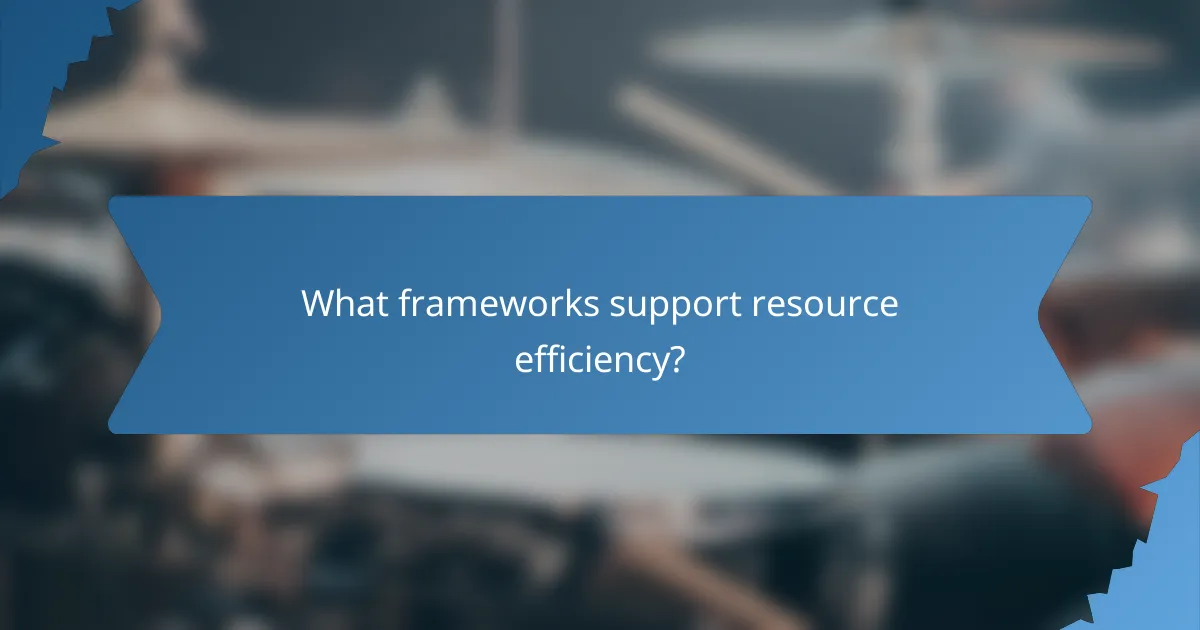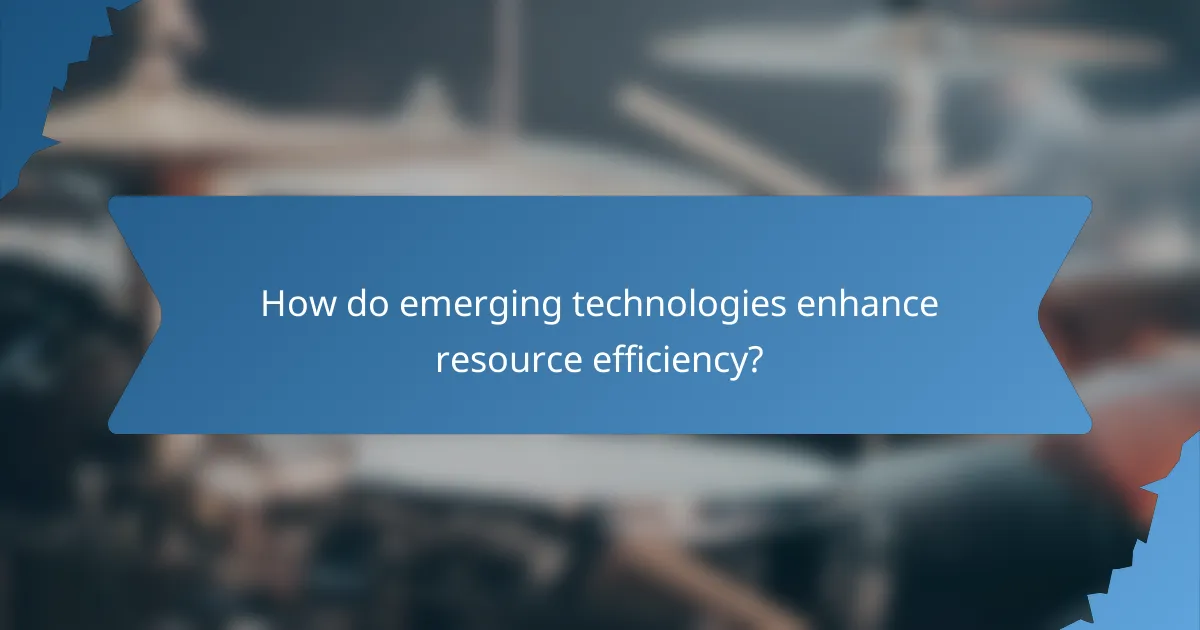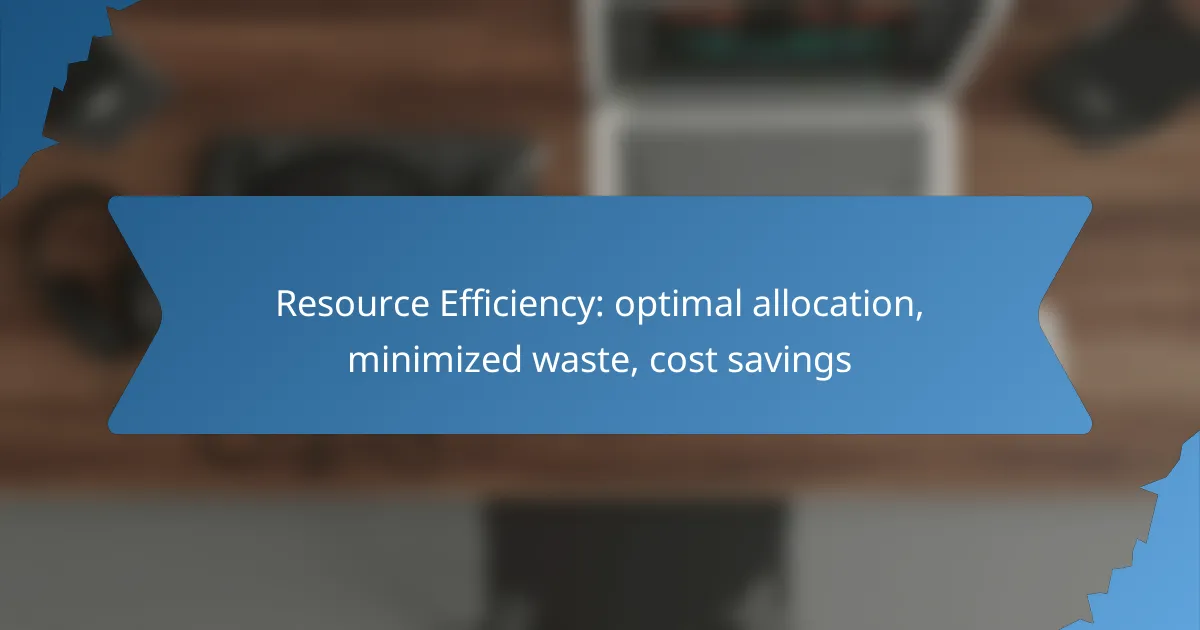Resource efficiency is crucial for businesses aiming to optimize operations while minimizing waste and costs. By strategically allocating resources and adopting sustainable practices, companies can enhance productivity and achieve significant cost savings. This approach not only improves the bottom line but also fosters a positive environmental impact, aligning with modern regulatory standards and consumer expectations.

How can businesses in Canada optimize resource efficiency?
Businesses in Canada can optimize resource efficiency by implementing strategies that reduce waste and enhance productivity. This involves adopting practices that streamline operations, utilize technology effectively, and embrace sustainable methods to minimize costs.
Implementing lean management techniques
Lean management focuses on maximizing value while minimizing waste. Businesses can start by identifying non-value-added activities in their processes and eliminating them. Techniques such as value stream mapping can help visualize workflows and pinpoint areas for improvement.
Common lean practices include just-in-time inventory, which reduces excess stock and storage costs, and continuous improvement (Kaizen), encouraging employees to suggest enhancements. These methods can lead to significant cost savings and more efficient resource use.
Utilizing energy-efficient technologies
Investing in energy-efficient technologies can significantly lower operational costs and reduce environmental impact. Options include LED lighting, energy-efficient HVAC systems, and smart meters that monitor energy consumption in real-time.
Businesses should assess their energy usage and consider upgrading to technologies that offer better efficiency ratings. For instance, switching to ENERGY STAR-certified appliances can lead to savings of 10-50% on energy bills, depending on the equipment.
Adopting circular economy practices
The circular economy emphasizes reusing and recycling materials to extend their lifecycle and reduce waste. Businesses can adopt practices such as product take-back schemes, where customers return used products for refurbishment or recycling.
Implementing circular strategies not only conserves resources but can also create new revenue streams. For example, companies can sell refurbished items or repurpose waste materials into new products, enhancing sustainability and profitability.
Leveraging data analytics for resource allocation
Data analytics enables businesses to make informed decisions about resource allocation by analyzing consumption patterns and operational efficiency. Utilizing software tools can provide insights into areas where resources are underutilized or wasted.
By employing predictive analytics, companies can forecast demand more accurately, ensuring that resources are allocated effectively. This approach helps in optimizing inventory levels and reducing excess costs, ultimately leading to better resource efficiency.

What are the benefits of minimizing waste?
Minimizing waste leads to significant benefits, including cost savings, enhanced brand reputation, and compliance with environmental regulations. By optimizing resource allocation and reducing excess, businesses can improve their bottom line while contributing positively to the environment.
Cost savings through reduced material usage
Reducing material usage directly translates to cost savings. Companies can lower their expenses by purchasing fewer raw materials, which can lead to savings in transportation, storage, and disposal costs. For instance, businesses that adopt lean manufacturing techniques often see reductions in material costs by 20-30%.
To achieve these savings, organizations should conduct regular audits of their material usage and identify areas for reduction. Implementing recycling programs and reusing materials can further enhance savings, allowing companies to maximize their resources efficiently.
Improved brand reputation and customer loyalty
Minimizing waste can significantly enhance a brand’s reputation. Consumers increasingly prefer to support businesses that demonstrate environmental responsibility. Companies that actively reduce waste can attract eco-conscious customers, leading to increased loyalty and repeat business.
To build a strong reputation, businesses should communicate their waste reduction efforts through marketing and social media. Transparency about sustainability practices can foster trust and encourage customers to choose their products over competitors.
Compliance with environmental regulations
Minimizing waste helps businesses comply with various environmental regulations that aim to reduce pollution and promote sustainability. Many countries have established strict guidelines regarding waste management, and adhering to these can prevent costly fines and legal issues.
Organizations should stay informed about local regulations and implement waste reduction strategies that align with these requirements. Regular training for employees on compliance and best practices can further ensure that the business meets its environmental obligations while minimizing waste effectively.

What strategies can be employed for cost savings?
Cost savings can be achieved through various strategies that focus on resource efficiency, optimal allocation, and waste minimization. By implementing these strategies, businesses can significantly reduce expenses while enhancing their operational effectiveness.
Investing in renewable energy sources
Investing in renewable energy sources, such as solar or wind, can lead to substantial long-term cost savings. These energy sources often have lower operational costs compared to traditional fossil fuels and can provide tax incentives or rebates, depending on local regulations.
For instance, companies that install solar panels may see a reduction in their electricity bills by 20-50% over time. Additionally, renewable energy can protect businesses from fluctuating energy prices, ensuring more predictable budgeting.
Streamlining supply chain processes
Streamlining supply chain processes involves optimizing logistics, reducing lead times, and improving inventory management. By analyzing and refining these processes, businesses can minimize costs associated with excess inventory and transportation inefficiencies.
Implementing just-in-time inventory systems can help reduce storage costs and waste. Companies should regularly assess their suppliers and logistics partners to ensure they are getting the best value and service possible.
Conducting regular waste audits
Conducting regular waste audits allows businesses to identify areas where waste can be minimized, leading to cost savings. These audits help pinpoint inefficiencies in production processes and highlight opportunities for recycling or repurposing materials.
For example, a manufacturing company might discover that up to 30% of its raw materials are wasted during production. By addressing these issues, the company can not only save on material costs but also enhance its sustainability efforts, which can improve its brand image and customer loyalty.

What frameworks support resource efficiency?
Several frameworks support resource efficiency by promoting optimal allocation, minimizing waste, and achieving cost savings. Key methodologies include ISO 14001 environmental management standards and Lean Six Sigma methodologies, both of which provide structured approaches to enhance sustainability and operational effectiveness.
ISO 14001 environmental management standards
ISO 14001 is a globally recognized standard that outlines the requirements for an effective environmental management system (EMS). Organizations use this framework to improve resource efficiency by systematically managing their environmental responsibilities, which can lead to reduced waste and lower operational costs.
Implementing ISO 14001 involves several steps, including establishing an environmental policy, setting objectives, and conducting regular audits. Organizations often find that aligning their operations with these standards not only enhances compliance with regulations but also fosters a culture of sustainability.
For example, a manufacturing company might reduce its energy consumption by 20% within a year by adopting ISO 14001 practices, leading to significant cost savings. Regularly reviewing and updating practices ensures continuous improvement in resource efficiency.
Lean Six Sigma methodologies
Lean Six Sigma combines Lean manufacturing principles with Six Sigma quality management to enhance resource efficiency. This methodology focuses on eliminating waste and reducing variability in processes, which can lead to more efficient use of resources and lower costs.
Key steps in Lean Six Sigma include defining the problem, measuring current performance, analyzing data, improving processes, and controlling future performance. By applying tools such as value stream mapping and root cause analysis, organizations can identify inefficiencies and implement targeted improvements.
For instance, a service organization might streamline its operations to cut processing time by 30%, resulting in faster service delivery and increased customer satisfaction. Regular training and engagement of employees in Lean Six Sigma initiatives are crucial for sustaining improvements in resource efficiency.

How do emerging technologies enhance resource efficiency?
Emerging technologies significantly improve resource efficiency by optimizing allocation, reducing waste, and driving cost savings. These advancements leverage data and automation to streamline processes and enhance decision-making.
AI for predictive maintenance
AI enhances resource efficiency through predictive maintenance by analyzing data from machinery and equipment to forecast potential failures. This proactive approach minimizes downtime and extends the lifespan of assets, leading to substantial cost savings.
For example, manufacturing plants using AI-driven analytics can reduce maintenance costs by up to 30% by scheduling repairs only when necessary. Implementing AI tools requires initial investment but can yield significant long-term benefits.
IoT for real-time resource monitoring
The Internet of Things (IoT) facilitates real-time monitoring of resources, allowing businesses to track usage patterns and identify inefficiencies. Sensors collect data on energy consumption, water usage, and material waste, enabling timely interventions.
For instance, a facility that employs IoT sensors can reduce energy costs by 10-20% by adjusting usage based on real-time data. Companies should ensure robust data security measures are in place to protect sensitive information while leveraging IoT technologies.
